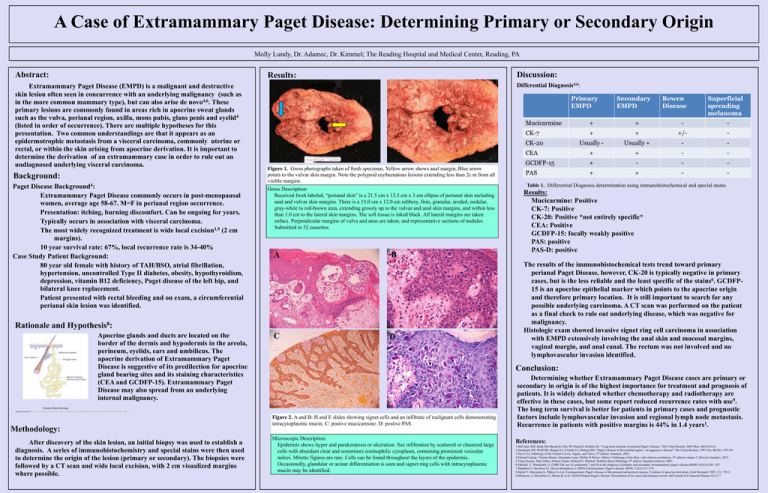A Case of Extramammary Paget Disease: Determining Primary or Secondary... Abstract: Results:
advertisement

A Case of Extramammary Paget Disease: Determining Primary or Secondary Origin Molly Lundy, Dr. Adamec, Dr. Kimmel; The Reading Hospital and Medical Center, Reading, PA Abstract: Extramammary Paget Disease (EMPD) is a malignant and destructive skin lesion often seen in concurrence with an underlying malignancy (such as in the more common mammary type), but can also arise de novo4,6. These primary lesions are commonly found in areas rich in apocrine sweat glands such as the vulva, perianal region, axilla, mons pubis, glans penis and eyelid4 (listed in order of occurrence). There are multiple hypotheses for this presentation. Two common understandings are that it appears as an epidermotrophic metastasis from a visceral carcinoma, commonly uterine or rectal, or within the skin arising from apocrine derivation. It is important to determine the derivation of an extramammary case in order to rule out an undiagnosed underlying visceral carcinoma. Background: Paget Disease Background4: Extramammary Paget Disease commonly occurs in post-menopausal women, average age 58-67. M=F in perianal region occurrence. Presentation: itching, burning discomfort. Can be ongoing for years. Typically occurs in association with visceral carcinoma. The most widely recognized treatment is wide local excision1,9 (2 cm margins). 10 year survival rate: 67%, local recurrence rate is 34-40% Case Study Patient Background: 80 year old female with history of TAH/BSO, atrial fibrillation, hypertension, uncontrolled Type II diabetes, obesity, hypothyroidism, depression, vitamin B12 deficiency, Paget disease of the left hip, and bilateral knee replacement. Patient presented with rectal bleeding and on exam, a circumferential perianal skin lesion was identified. Rationale and Discussion: Results: Differential Diagnosis4,6: A B Figure 1. Gross photographs taken of fresh specimen. Yellow arrow shows anal margin, Blue arrow points to the vulvar skin margin. Note the polypoid erythematous lesions extending less than 2c m from all visible margins. Gross Description: Received fresh labeled, “perianal skin” is a 21.5 cm x 13.5 cm x 3 cm ellipse of perianal skin including anal and vulvar skin margins. There is a 15.0 cm x 12.0 cm rubbery, firm, granular, eroded, nodular, gray-white to red-brown area, extending grossly up to the vulvar and anal skin margins, and within less than 1.0 cm to the lateral skin margins. The soft tissue is inked black. All lateral margins are taken enface. Perpendicular margins of vulva and anus are taken, and representative sections of nodules. Submitted in 52 cassettes. A B 8 Hypothesis : Apocrine glands and ducts are located on the border of the dermis and hypodermis in the areola, perineum, eyelids, ears and umbilicus. The apocrine derivation of Extramammary Paget Disease is suggestive of its predilection for apocrine gland bearing sites and its staining characteristics (CEA and GCDFP-15). Extramammary Paget Disease may also spread from an underlying internal malignancy. C D Image borrowed from: http://www.bing.com/images/search?q=apocrine+gland&view=detail&id=BD8B3252D4```4B9D416B1631BAB093DDC6EF8F9177&first=1 After discovery of the skin lesion, an initial biopsy was used to establish a diagnosis. A series of immunohistochemistry and special stains were then used to determine the origin of the lesion (primary or secondary). The biopsies were followed by a CT scan and wide local excision, with 2 cm visualized margins where possible. Results: Mucicarmine: Positive CK-7: Positive CK-20: Positive *not entirely specific* CEA: Positive GCDFP-15: focally weakly positive PAS: positive PAS-D: positive The results of the immunohistochemical tests trend toward primary perianal Paget Disease, however, CK-20 is typically negative in primary cases, but is the less reliable and the least specific of the stains6. GCDFP15 is an apocrine epithelial marker which points to the apocrine origin and therefore primary location. It is still important to search for any possible underlying carcinoma. A CT scan was performed on the patient as a final check to rule out underlying disease, which was negative for malignancy. Histologic exam showed invasive signet ring cell carcinoma in association with EMPD extensively involving the anal skin and mucosal margins, vaginal margin, and anal canal. The rectum was not involved and no lymphovascular invasion identified. Conclusion: Perianal Skin Histology Methodology: Table 1. Differential Diagnosis determination using immunohistochemical and special stains Figure 2. A and B: H and E slides showing signet cells and an infiltrate of malignant cells demonstrating intracytoplasmic mucin. C: postive mucicarmine. D: postive PAS. Microscopic Description: Epidermis shows hyper and parakeratosis or ulceration. See infiltration by scattered or clustered large cells with abundant clear and sometimes eosinophilic cytoplasm, containing prominent vesicular nulcei. Mitotic figures are rare. Cells can be found throughout the layers of the epidermis. Occasionally, glandular or acinar differentiation is seen and signet ring cells with intracytoplasmic mucin may be identified. Determining whether Extramammary Paget Disease cases are primary or secondary in origin is of the highest importance for treatment and prognosis of patients. It is widely debated whether chemotherapy and radiotherapy are effective in these cases, but some report reduced recurrence rates with use9. The long term survival is better for patients in primary cases and prognostic factors include lymphovascular invasion and regional lymph node metastasis. Recurrence in patients with positive margins is 44% in 1.4 years1. References: 1.McCarter MD, Quan SH, Busam K, Paty PP, Wong D, Guillem JG. “Long-term outcome of perianal Paget’s disease.” Dis Colon Rectum. 2003 May; 46(5):612-6. 2.Sarmiento JM, Wolff BG, Burgart LJ, Frizelle FA, Illstrup DM. “Paget’s disease of the perianal region—an aggressive disease?” Dis Colon Rectum. 1997 Oct; 40(10): 1187-94. 3.Yao S. Fu, Pathology of the Uterine Cervix, Vagina, and Vulva, 2nd edition. Saunders, 2002. 4.Eduard Calonje, Thomas Brenn, Alexander Lazar, Phillip H Mckee. Mckee’s Pathology of the Skin, with clinical correlations, 4th edition volume 2. Elsevier Saunders, 2012. 5.Vinay Kumar, Abul Abbas, Nelson Fausto, Richard N. Mitchell. Robbins Basic Pathology, 8th edition. Saunders Elsevier, 2007. 6.Ohnishi, T., Wantanabe, S. (2000) The use of cytokeratin 7 and 20 in the diagnosis of primary and secondary extramammary paget’s disease.BJOD 142(12):243- 247. 7.Shepherd V, Davidson EJ, Davies-Humphreys J (2005) Extramammary Paget’s disease. BJOG 112(3):273–279. 8.Merot Y, Mazoujian G, Pinkus G et al. Extramammary Paget’s disease of the perianal and perineal regions. Evidence of apocrine derivation. Arch Dermatol 1985; 121: 750 2. 9.Minicozzi A, Borzellino G, Momo R, et al. (2010) Perianal Paget’s Disease: Presentation of six cases and literature review. Intl Journal of Colorectal Disease 5(1):1-7 A Pathologists’ Assistant’s Gross Description Expedites the Diagnosis of an Uncommon Benign Multicystic Tumor in the Adult Kidney: A Case Report and Review of the Literature Steven Suvalsky MHS, PA(ASCP)* and Larry Anderson M.D.** Iowa Health-Des Moines* and Iowa Pathology Associates**, Des Moines, IA 50309 Abstract: The Pathologists’ Assistant’s (PA’s) gross descriptions are essential to the pathologist for the differential diagnoses of both benign and malignant tumors. For example, concise, gross descriptions are extremely important in multicystic renal tumors in adults. When the PA recognizes and describes specific tumor features in these cases, the pathologist can diagnose both intraoperative and final reports more efficiently. Descriptive names for encapsulated multicystic renal tumors arise from a spectrum of histologic findings and numerous theories of pathogenesis. The Multicystic Nephroma or Multilocular Cystic Nephroma described in this case report is one such uncommon, but specific benign tumor that can present at any age and is recognized by gross appearances. Histologic examination of this Multicystic Nephroma was identical to the microscopic features cited in the literature reviewed. This benign tumor was expected as the gross description suggested and followed microscopic verification from the sections selected by the PA. Discussion: Results: A The gross description of the left nephrectomy by the PA noted a well delineated multiloculated cystic mass and preserved normal parenchyma. The CT scan reported by the radiologist described an extensively septated cystic renal mass suspicious for a multilocular cystic renal cell carcinoma or a partially cystic dysplastic kidney. B Radiologic Differential on Abdominal CT Scan Benign Multicystic Cystic Partially Cystic dysplastic Nephroma differentiated kidney nephroblastoma (CPDN) Background: The pathologists’ assistant (PA) is an intensively trained allied health professional who provides anatomic pathology services under the direct supervision of a pathologist (1). Valuable experience occurs on a daily basis both on the surgical pathology bench and in the autopsy room. Gross examination and feed-back of the final diagnoses between the PA and attending pathologist create a valuable partnership of gross recognition and microscopic verifications. When gross descriptive communication and microscopic verification are utilized, time-consuming dictations and voluminous sections can be avoided. The utilization of pathologists’ assistants in histopathology has been shown to expedite diagnoses and ultimately enhance patient care (2). The case is a 64 year old caucasian male who was hospitalized for lower extremity claudication. His past medical history was generalized arteriosclerotic heart disease and peripheral vascular disease. A 12 cm. solitary cystic mass on an abdominal CT scan was found in the mid portion of his left kidney during workup. A left nephrectomy followed with histopathologic examination of the mass (Fig 1-3). The gross appearance of the solitary and multiloculated cystic mass was unlike that of a multiloculated renal cell carcinoma or a diffuse process such as polycystic kidney (PKD) disease. The diagnosis was a Multicystic Nephroma, a benign cystic tumor of the left kidney. There was no additional tumor treatment required following the nephrectomy. Figure 1. Photomacrographs of the left kidney. (L/R). A. Perinephric fat margins with multifocal loculations and a dilated pelvis. B. The cut surface of the kidney demonstrating a solitary (13 cm.) multiloculated cystic mass. Note the normal, preserved parenchyma in the lower lateral portions including the lower pole (white arrows) and the dilated pelvis (red arrows). Gross Description: “labeled left kidney is an 18 cm. in maximum dimension portion of fat (perinephric) without adrenal tissue or nodules. There is a 15 X 14 X 9 cm. distorted kidney within this fat. An area of multiloculated and well delineated distended kidney spans 13 cm. in maximum dimension including distention of the pelvis suggestive of hydronephrosis. The loculations are smooth with clear colorless fluid to gelatinous material contents. The remaining kidney is unremarkable with smooth cortices and slightly blunted papillary tips. The corticomedullary junctions are well delineated. The ureter is thick-walled. The pelvoureteral junction is patent with a 1 mm. in diameter probe. There are no mass lesions or excrescences in the pelvis or ureter. The vascular margins are unremarkable.” Microscopic log: A1. Vascular and ureteral margins. A2-4. Selected multiloculated area. A5. Normal, preserved kidney. Multilocular Cystic Renal Tumors Multicystic Nephroma CPDN Solitary well-circumscribed multiseptated 3-13 cm. (ave. 6.7 cm.) Most commonly in the lower pole Absence of hemorrhage or necrosis Secondary obstructions of the pelvis & ureter (herniations) Mortality is related only to single function kidney Common ages: males< 4 yrs. , Females > 30 yrs. Histologically distinct Histologically distinct (Septae without embryonal elements) (Septae with blastemal & embryonal elements) ? Biologically different? The pathologists’ assistant is a highly skilled professional responsible for the gross examination and dissection of histopathologic specimens: This includes measurements, recognition of normal and abnormal features, further dissection and the selection of specific lesions/areas for microscopic examination. Additional examinations by this professional may include specimen photomacrography, review of the patient’s past medical history, review of the clinical consultations and review of laboratory tests and radiologic reports. The multiloculated cystic mass was well delineated without evidence of invasion into adjacent and preserved renal tissue. There was dilatation of the renal pelvis and thickness of the ureter without a ureteral obstruction or mass. A C The gross examination of the left nephrectomy utilized a routine and established procedure as for any specimen received by the PA under the supervision of the pathologist. i.e. margins inked, specimen oriented and measured, photographed, weighed and examined both fresh and following 10% buffered formalin fixation. Multilocular cystic Renal Cell Carcinoma A case report in 1956 by Boggs and Kimmelstiel proposed Multilocular Cystic Nephroma (3). Originally considered a lesion of malignant potential, Joshi and Beckwith later proposed a modification that emphasized a subset based on histology. The Multicystic Nephroma and the CPDN became subsets of the category multilocular cystic renal tumors (3,4). Rationale and Hypothesis: Methodology: Malignant Figure 2. Abdominal CT scan demonstrating a cystic abnormality of the left kidney (arrows). Conclusion: B D Figure 3. Photomicrographs (L to R.) A. H&E 10X of loculations with fibrous stroma. B. H&E 4X of juncture with normal kidney. C. H&E 40X of preserved tubule within a fibrous septa. D. H&E 100X lining of a locule with cuboidal epithelium “hobnail appearance”. Microscopic Description and Summary: H & E stains show that the mass is a multicystic lesion. The cysts are lined by cuboidal epithelium which in some areas are somewhat hobnail. There are no areas of malignancy or atypia. The stroma between the cysts are fibrous. Sections away from the mass show normal renal parenchyma. The diagnosis is a Multicystic Nephroma. Malignancy is not identified. Multicystic renal tumors in adults are one example where concise, gross descriptions by the Pathologists’ Assistant (PA) are extremely important and have shown to expedite the diagnosis when specific gross tumor features are recognized by the PA and conveyed to the pathologist. The benign solitary tumor termed “Multicystic Nephroma” or “Multilocular Cystic Nephroma” is uncommon at any age and may have more aggressive behavior if blastema or embryonal elements are seen microscopically in the fibrous septae of the locules/cyst. Ultrasonography is the preferred non-invasive study for diagnosis and when combined with CT or MRI scans offer more detailed evaluation of the cystic lesion and stromal tissue. Histologic examination of this Multicystic Nephroma in a 64 year-old male was identical to the microscopic features cited in the literature reviewed. References: 1. 2. 3. 4. Official website of the American Association of Pathologists’ Assistants, founded in 1972. http:www.pathologistsassistants.org. Grzybicki D.M., Galvis C.O., & Raab, S.S.: The Usefulness of Pathologists’ Assistants. American Journal of Clinical Pathology, 112:619-626, 1999. Lederman, H.M. and Hurh, P.J.: Multilocular Cystic Nephroma. Emedicine from WebMD, April, 2003. Ordonex, N.G. & Rosai, J.: Rosai and Ackerman’s Surgical Pathology. Ninth Edition., Vol. 1, Chapter 17, pp. 1246-1247. 2004.







